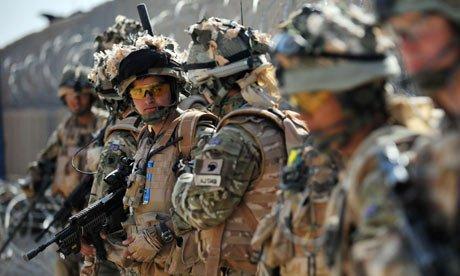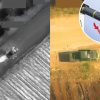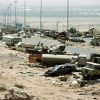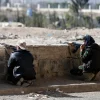The Brigade of Gurkhas has been a highly esteemed unit within the British Army for many years. Comprised of Nepalese soldiers, also known as Gorkhali, they are not only recruited by the British Army but also by the Nepalese and Indian Armies, as well as in Gurkha Contingent Singapore and the Gurkha Reserve Unit Brunei. Furthermore, these skilled soldiers are often called upon to serve as part of UN peacekeeping forces and in various war zones around the globe.
Introduction
The Gurkhas are a group of people hailing from Nepal. According to legend, “Gurkha” originates from a warrior saint named Guru Gorkhanath, who lived over a millennium ago. The legend claims that Guru Gorkhanath foretold that his people would become renowned for their valor and courage, a prophecy that has undoubtedly come true. Adhering to the motto “Better to die than be a coward,” the Gurkhas have proven themselves to be some of the bravest soldiers in the world.
History
The Gurkhas, a group of unknown soldiers from the mountainous regions of Nepal, were brought to the world’s attention when the British East India Company invaded them over two centuries ago. The British, armed with advanced firearms, were met with fierce resistance by the Gurkhas armed with traditional Kukri knives.

According to legend, a Kukri had to “taste blood” in battle, or the owner was obligated to cut himself before sheathing it. Despite the disparity in weaponry, the Nepali soldiers fought with exceptional courage and strategy, causing significant casualties to the British forces. After six months of conflict, the British sought to sign a peace treaty with Nepal, which included terms allowing the Gurkhas to join the East India Company’s Army. Since then, more than 200,000 Gurkhas have participated in nearly every military campaign in which the British have been involved.
The Heroism of the Gurkhas
During the First World War, approximately 100,000 Gurkhas fought on battlefields in France and various other countries. In the Second World War, it is estimated that around 250,000 Gurkhas were enlisted to fight for the British. They were utilized to quell revolts in India and also fought in Syria, North Africa, Italy, Greece, and against the Japanese in Singapore and the jungles of Burma. One notable example of the bravery of a Gurkha soldier is Rifleman Lachhiman Gurung, who is a testament to their courage and skill.

In the year 1945, Rifleman Lachhiman Gurung found himself in a trench alongside two other soldiers when they were attacked by 200 Japanese fighters. After his comrades were injured, Gurung noticed several grenades falling into his position. He threw them back but the third one exploded in his right hand, causing severe injuries.
Despite this, Gurung managed to use his left hand to shoot and kill several Japanese soldiers as they attempted to storm his trench. In total, 31 Japanese soldiers were killed during the intense battle.
While their bravery is undeniable, it comes at a high cost – 43,000 of these courageous soldiers lost their lives in World Wars I and II. Despite these heavy casualties, their heroism has not gone unrecognized. 26 Victoria Crosses, the United Kingdom’s highest award for valor, have been bestowed upon Gurkha Regiments.
In the past half-century, they have served in various locations, including Hong Kong, Malaysia, Borneo, Cyprus, the Falklands, Kosovo, Iraq, and Afghanistan. The British are not the only nation to benefit from the Gurkhas’ services; Singapore, Malaysia, and India have all employed them in their armies and police forces.

Brigade of Gurkhas
The Brigade of Gurkhas is a regular component of the British Army and is widely considered an elite unit. Established on August 15, 1951, the Brigade boasts a strength of 3,640 soldiers. The term “Brigade of Gurkhas” refers to units within the current British Army composed of Nepalese soldiers. Its heritage can be traced back to Gurkha units that initially served in the Indian Army before Indian independence and before that of the East India Company.

The Brigade of Gurkhas comprises various units, such as infantry, engineers, signals, logistics, and training and support units, capable of undertaking diverse mission objectives. As previously mentioned, they are known for their iconic Kukri knives with curved blades, which are heavy knives.
“If a man says he is not afraid of dying, he is either lying or is a Gurkha.”
former Indian Army Chief of Staff Field Marshal Sam Manekshaw
The ranks within the Brigade of Gurkhas are primarily comprised of four distinct ethnic groups: the Gurungs and Magars from western Nepal and the Rais and Limbus from the east, who hail from the hill villages of hill farmers. These soldiers are renowned for their exceptional bravery and discipline, particularly in the British and Indian Armies.
Throughout history, the British recruited Gurkhas in their colonial Army, as they were recognized as brave, professional, and highly disciplined warriors. Today, Gurkhas remain elite soldiers in British and Indian troops and frequently fight alongside Special Air Service and Special Boat Service operators.
Selection and Training
The selection process for becoming a Gurkha is a rigorous and challenging endeavor for each candidate. Every year, the British and Indian governments recruit Gurkhas from Nepal. This is a highly competitive recruitment process that thousands of young Nepali men go through, but only a select few are successful. Out of the 25,000 candidates who typically apply for 200 available places, only the most exceptional can pass the rigorous tests and selection process and are ultimately granted the opportunity to begin basic training.

Recruitment
The recruitment process for becoming a Gurkha soldier involves two stages of selection. The first stage is the regional selection, which takes place in either Pokhara or Dharan. It includes a series of physical tests, written assessments in English and numeracy, and an interview. Candidates who pass the regional selection move on to the second stage, the central selection process in Kathmandu, which includes additional physical and language tests, a medical examination, and a second interview.
Basic training
The training for becoming a Gurkha soldier lasts for 36 weeks. It covers a range of subjects, including the Brigade’s ethos, language training, cultural training, career management, trade selection, and the same 26-week Combat Infantryman’s Course that the Line Infantry receives. This comprehensive training enables the Gurkhas soldiers to effectively fulfill their operations roles and carry on their forefathers’ traditions.
In addition to recruiting soldiers for the British Army, British Gurkhas Nepal also manages the recruitment process for the Gurkha Contingent of the Singapore Police Force. At the registration stage, candidates can indicate whether they wish to join the Singapore Police or the British Army.
Gurkhas in SAS
Many Gurkhas serve in the SAS (Special Air Service) and are involved in top-secret operations as part of one of the world’s most elite fighting forces. Their cultural heritage plays a crucial role in undercover missions in Islamic countries. The ability to speak Urdu – a dialect prevalent in Asian war zones – grants them a valuable advantage in these areas.
A source said: “The makeup of the SAS is very secretive but we now know that there are 12 Gurkhas in the ranks. It’s extremely difficult to get in and they only take the best of the best. It’s a massive feather in the cap for any soldier who makes it. It’s also a very proud thing for that soldier’s own regiment. For the Gurkhas to now have 12 of their own in the most elite fighting force in the world is testament to their indomitable spirit and physical toughness.”

Organizational structure
The Brigade of Gurkhas’ headquarters is at Trenchard Lines, Upavon, Wiltshire. The two battalions of the Royal Gurkha Rifles are structured as light-role infantry and do not possess any armored or wheeled vehicles. One battalion is stationed at Shorncliffe Army Camp near Folkestone in Kent as part of the 52 Infantry Brigade and is available for deployment to most regions in Europe and Africa. The other is based at the British garrison in Brunei as part of the UK’s commitment to maintaining a military presence in Asia.
Structure diagram
- HQ, Brigade of Gurkhas, at the Royal Military Academy Sandhurst in Surrey
- British Gurkhas Nepal – recruits for the British Army and Singapore Police, handles soldier and ex-soldier welfare
- 1st Battalion, The Royal Gurkha Rifles in Shorncliffe – an air assault infantry battalion, part of 16 Air Assault Brigade
- 2nd Battalion, The Royal Gurkha Rifles in Brunei – a light infantry battalion, part of British Forces Brunei
- 3rd Battalion, The Royal Gurkha Rifles in Aldershot Garrison – a specialized infantry unit, part of the Specialised Infantry Group
- 10 Queen’s Own Gurkha Logistic Regiment RLC, in Aldershot
- Queen’s Gurkha Engineers
- 69 Gurkha Field Squadron (part of 36 Engineer Regiment), in Maidstone
- 70 Gurkha Field Support Squadron (part of 36 Engineer Regiment), in Maidstone
- Queen’s Gurkha Signals
- 246 Squadron (part of 2 Signal Regiment), in York
- 247 Squadron (part of 16 Signal Regiment)
- 248 Squadron (part of 22 Signal Regiment), in Stafford
- 249 Squadron (part of 3rd (UK) Division HQ and Signal Regiment), in Bulford
- 250 Squadron (provides command support to Commander Joint Forces Operation and his Staff when deployed), in Bramcote
- Brunei Signal Troop, in Brunei, supporting British Forces Brunei
- Nepal Signal Troop, in Kathmandu, supporting HQ British Gurkhas Nepal
- Gurkha Staff and Personnel Support Company – administration for all Brigade of Ghurkas units
- Band of the Brigade of Gurkhas (raised in November 1859)
- Gurkha Company Catterick at the Infantry Training Centre, Catterick
- Gurkha Company (Sittang) at the Royal Military Academy Sandhurst
- Gurkha Wing (Mandalay) at the Infantry Battle School, Brecon
- Gurkha Training Support Company (Tavoleto) at Waterloo Lines, Warminster
- Brigade Training Team
- Nepali Language Wing, Catterick
In 2018, the United Kingdom’s government announced plans to expand the Brigade of Gurkhas by over 800 positions. The Queen’s Gurkha Engineers were set to receive an additional squadron, and the Queen’s Gurkha Signals and the Queen’s Own Gurkha Logistic Regiment were to welcome two new squadrons. Additionally, around 300 recent posts within the Royal Gurkha Rifles were established, forming a new battalion intended for the Specialist Infantry role. For the first time, in 2020, women were allowed to join units within the Brigade.
Awards and commendations
Awards
The Brigade of Gurkhas has been awarded 26 Victoria Crosses, 13 of which were given to British officers and 13 to the Gurkha soldiers. This makes the Gurkha Brigade one of the most highly decorated regiments in the British Army.
London memorial
On December 3, 1997, Queen Elizabeth II unveiled the British memorial dedicated to the Gurkhas. The inscription on the monument is a quote from Sir Ralph Turner, a former officer in the 3rd Gurkha Rifles.
200 years of service
In 2015, several events were held to commemorate the 200 years of service by the Gurkhas in the British Army, one of which was a march past Buckingham Palace.








